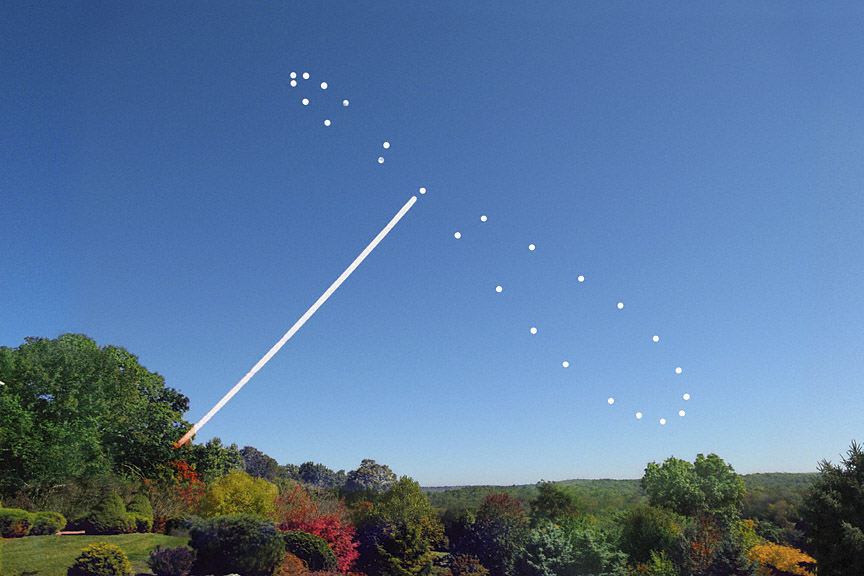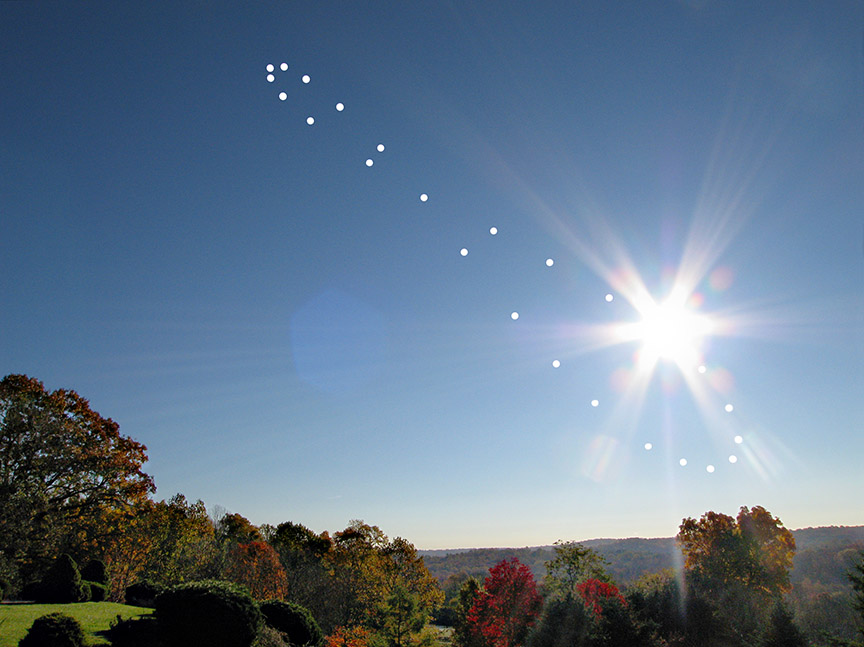

| 
|

The position of the Sun in the sky shifts north-south summer to winter, giving us our seasons. It also shifts east-west, crossing the meridian more than 15 minutes early in the fall and late in the winter (making uncorrected sundials poor timekeepers). A graph or photo of the Sun's position in the sky at a particular time throughout the year is known as ananalemma.One often appears on globes. Its figure-8 shape comes from a combination of two factors:
- the tilt of the Earth's axis with respect to the plane in which it orbits the Sun and
- the elliptical shape of the Earth's orbit around the Sun.
The above picture is a wide-angle, multiple-exposure, time-lapse composite photograph of the Sun's analemma. The dots in the sky are photos of the Sun taken through a special solar filter at 8:02 a.m. EST roughly every two weeks from December 20, 2005 to December 8, 2006. The three streaks are trails of the Sun rising from dawn until 7:58 a.m. EST on three different days. The Sun trails were created by combining hundreds of individual digital photos taken every 20 seconds. The last Sun trail was taken on June 18, 2007. The foreground was taken in October 2006. The exposures were also combined into a video of the analemma.
All photos used to compose the above image were taken using a digital camera on a mount permanently attached to a large rock. The digital photos were taken as part of a year-long project to take an analemma photo using a single piece of film, as was first done by Dennis DiCicco in 1978-79. I originally intended to use the digital camera merely as a tool for judging the film exposure needed with varying sky conditions. I quickly realized, however, that lots of things can go wrong with a single piece of film over the course of a year, so I took the digital photos as a back-up to the film-based image. The film-based image is shown below.

The images of the Sun, the Sun trail, and the background on the above film-based image were all exposed on a single frame of film over the course of a year. The exposures of the Sun were made at 8:00 a.m. EST and, when clouds allowed, the matching digital photos were taken two minutes later. Sometimes clouds forced me to make the film and digital exposures on different days. You can see how many clouds I was working around in the video made from the digital images. The landscape image was exposed on film on October 8, 2006. The Sun trail was taken as one long exposure on film through a pair of stacked filters. I had hoped to expose three Sun trails on film, but weather prevented it. The flexibility afforded by digital imaging allowed me to add all three Sun trails to the final digital image, to expand the field of view to include the house on the left, and to make the associated analemma movie.

Another view of the analemma, using an unfiltered digital frame taken October 27, 2006 for the background. An image similar to this one was used as the cover photo for the analemma video as presented on Nasa's APOD site and also appeared on the "Know More" page of the Washington Post.
Digital photos were taken with a Canon S80 with exposures ranging from 1/60th to 1/250th seconds at f8 and ASA 100 through Baader AstroSolar solar filter material, ©2006 (second photo) & ©2007 (the rest of the photos). The film-based photo was taken with a 24mm Nikkor lens and a Nikon F3 on Fuji Reala 100 color negative film using similar exposures. The film-based Sun trail was taken as a single multi-hour exposure through two layers of AstroSolar, ©2006.
| |||||||||||||||||
|
Astrophotography Books – Astronomy Books |








